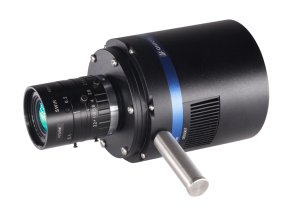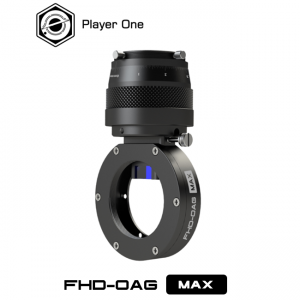QHY has introduced two new camera models, the QHY990 and the QHY991 offering cooled cameras with CMOS sensors covering the near infrared wavelength range.
 Both models use Sony InGaAs sensors with square pixels measuring 5µm x 5µm. The IMX990 is a 1.3-megapixel sensor and the IMX991 has a 0.4-megapixel array. The spectral response starts at 400 and ends at 1700 nanometres. The maximum quantum efficiency is 77 % at a wavelength of 1200 nanometres. With Cu-Cu interconnect technology, the camera’s sensor has a very low FPN noise and low defect pixel ratio.
Both models use Sony InGaAs sensors with square pixels measuring 5µm x 5µm. The IMX990 is a 1.3-megapixel sensor and the IMX991 has a 0.4-megapixel array. The spectral response starts at 400 and ends at 1700 nanometres. The maximum quantum efficiency is 77 % at a wavelength of 1200 nanometres. With Cu-Cu interconnect technology, the camera’s sensor has a very low FPN noise and low defect pixel ratio.
The QHY990 and the QHY991 cameras come with a 25mm filter holder, which is a common filter size for most laboratory applications. The SWIR (Short Wavelength Infrared) filter can be easily utilized inside the camera. With this adapter, the camera has the standard 17.5mm C-mount back focal distance.
There are both air cooling and liquid cooling options available for the cameras. With the air cooling method, the camera can achieve a delta of -35C degrees below ambient temperature. With room temperature liquid cooling, a delta of -45C degrees below ambient is achieved and with chilled liquid you can reach a delta of -60C to -80C below ambient. The liquid cooling version of this camera is recommended for applications that would require exposures to be longer than 5 seconds or more.
Both cameras utilize Sony’s SenSWIR technology, where photodiodes are formed on an indium gallium arsenide (InGaAs) compound semiconductor layer. These photodiodes are connected via Cu-Cu connection with the silicon (Si) layer, which forms the readout circuit. This design enables high sensitivity over a broad range of wavelengths. All of this results in a SWIR image sensor that is both compact and capable of delivering seamless image capture over a broad range of wavelengths, covering from the visible to invisible light spectrum in the short-wavelength infrared range (0.4μm to 1.7μm).
This technology is especially important because it is able to sense even in wavelengths that are not visible to the human eye. Sony’s sensors employ stacking technology using Cu-Cu connection that has been developed by Sony for years, along with Sony’s original SWIR image sensor technology. This leads to high image quality and a more compact sensor size as well as high sensitivity imaging in a broad range of wavelengths that cover both the visible and invisible spectrums.
When bonding the InGaAs layer that forms the light receiving photodiodes and the Si layer that forms the readout circuit, using conventional bump connections makes it necessary to secure a particular bump pitch. This makes it difficult to achieve a smaller pixel size compared to current CMOS industrial CMOS sensors. Therefore, miniaturization has been a major challenge. Sony’s new sensors feature a smaller pixel pitch that is made possible by the Cu-Cu connection, resulting in the industry’s smallest 5μm pixel size. In turn, it is possible to reduce camera size while maintaining VGA resolution, which contributes to improved testing precision.
While conventional SWIR image sensors usually have analog output, the cameras support digital output and deliver the same performance as current industrial CMOS image sensors. Analog output sensors typically require a digital conversion circuit or other functionality for industrial equipment on the camera, but these cameras have this technology built in. This reduces the number of steps in camera development, making multifunction camera development easier than ever.
Model QHY990 specifications:
– CMOS Sensor: IMX990 SWIR Sensor
– FPA Material: InGaAs
– Pixel Size: 5.0um x 5.0um
– Total Pixels: 1392 x 1052 (Including optically black pixels)
– Effective Pixel Area: 1296 x 1032
– Effective Pixels: 1.3 Megapixels
– Effective Image Area: 1/2-inch
– AD Sample Depth: 12-bit A/D
– Shutter Type: Electric Global Shutter
– QE: 77% @ 1200nm
– Full Well: 120ke – typical
– Typical Read Noise: 20e @ High Gain; 50e @ Med Gain; 150e @ Low Gain
– Frame Rate: 66 FPS @ Full Resolution 12-bit; 137 FPS @ 480 Lines 12-bit; 256 FPS @ 240 Lines 12-bit; 518 FPS @ 100 Lines 12-bit; 925 FPS @ 40 Lines 12-bit; 1150 FPS @20 Lines 12-bit
– Trig Function: Hardware Trig-In Socket (RCA type) Opto-isolated
– Cooling System: Dual Stage TE Cooler
– Cooling Performance: -35C below ambient w/ air cooling; -45C below ambient w/ room temp liquid cooling; -60C to -80C below ambient w/ chilled liquid cooling
– Computer Interface: USB3.0
– Lens Interface: C-Mount
– Telescope Interface: 1.25″ Adapter
– Basic Interface: Flange w/ 6-M3 screw holes
– Filter Adapter: Supports D=25mm and D=25.4mm filters
– Back Focal Length: C-Mount, 1.25″ adapter; 17.5mm with filter adapter; 14.5mm without filter adapter; 12.5mm with basic interface
Model QHY991 specifications:
– CMOS Sensor: IMX991 SWIR Sensor
– FPA Material: InGaAs
– Pixel Size: 5.0um x 5.0um
– Total Pixels: 752 x 520 (Including optically black pixels)
– Effective Pixel Area: 656 x 520
– Effective Pixels: 0.4 Megapixels
– Effective Image Area: 1/4-inch
– AD Sample Depth: 12-bit A/D
– Shutter Type: Electric Global Shutter
– QE: 77% @ 1200nm
– Full Well: 120ke – typical
– Typical Read Noise: 20e @ High Gain; 50e @ Med Gain; 150e @ Low Gain
– Frame Rate: 66 FPS @ Full Resolution 12-bit; 137 FPS @ 480 Lines 12-bit; 256 FPS @ 240 Lines 12-bit; 518 FPS @ 100 Lines 12-bit; 925 FPS @ 40 Lines 12-bit; 1150 FPS @20 Lines 12-bit
– Trig Function: Hardware Trig-In Socket (RCA type) Opto-isolated
– Cooling System: Dual Stage TE Cooler
– Cooling Performance: -35C below ambient w/ air cooling; -45C below ambient w/ room temp liquid cooling; -60C to -80C below ambient w/ chilled liquid cooling
– Computer Interface: USB3.0
– Lens Interface: C-Mount
– Telescope Interface: 1.25″ Adapter
– Basic Interface: Flange w/ 6-M3 screw holes
– Filter Adapter: Supports D=25mm and D=25.4mm filters
– Back Focal Length: C-Mount, 1.25″ adapter; 17.5mm with filter adapter; 14.5mm without filter adapter; 12.5mm with basic interface
You can learn more at here.
 And to make it easier for you to get the most extensive news, articles and reviews that are only available in the magazine pages of Astronomy Technology Today, we are offering a 1 year magazine subscription for only $6! Or, for an even better deal, we are offering 2 years for only $9. Click here to get these deals which only will be available for a very limited time. You can also check out a free sample issue here.
And to make it easier for you to get the most extensive news, articles and reviews that are only available in the magazine pages of Astronomy Technology Today, we are offering a 1 year magazine subscription for only $6! Or, for an even better deal, we are offering 2 years for only $9. Click here to get these deals which only will be available for a very limited time. You can also check out a free sample issue here.



